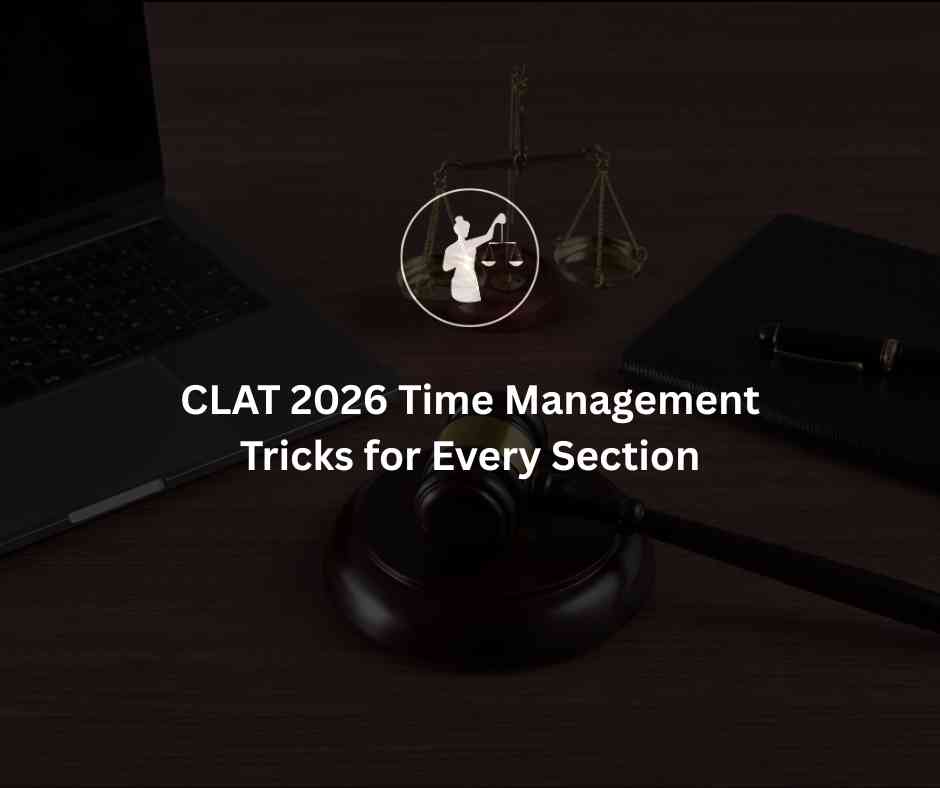
Summary
CLAT 2026, scheduled for December 7, 2025, demands not just knowledge but also strategic time management.
This guide shows you how to allocate your 120 minutes effectively across sections, Legal, Logical, English, GK, Quant so that clarity, accuracy, and speed align to help you perform confidently on test day.
CLAT is a two-hour exam filled with 120 multiple-choice questions across five sections.
Time mismanagement leads to stress and avoidable mistakes.
Experts highlight that effective time use, both in preparation and in exam-day execution, is what distinguishes top scorers.
According to competitive exam guides, habits like time-blocking, mock test routines, and daily micro-targets are essential in building discipline and consistency.
Explore the detailed CLAT 2026 Preparation Guide.
Based on preparation trends across platforms:
This time split ensures full coverage and allows a buffer to revisit skipped or marked questions .
CLAT’s question paper is non-sectored, allowing flexibility in order. Here’s how aspirants can optimize:
Start with your strength section to build confidence.
Quickly skim the paper first (2 minutes): gauge question difficulty and mark the easiest.
Stick to your planned time per section and move on even if questions remain. Revisiting later is always an option.
This neutralizes unproductive dwell time and helps maintain momentum .
Legal Reasoning
Identify core principles in 10–15 seconds by focusing on keywords.
Use structured practice of Principle + Facts templates.
Avoid over-analysis: if a principle doesn’t click, mark and revisit later.
English Language (RC & Vocabulary)
Skip reading questions before reading the passage; first grasp the context.
Spend only 6–7 minutes per passage aiming for accuracy; train on this pace during mocks.
Use rapid elimination while retaining choices that align with tone/context.
Logical Reasoning
Categorize questions (precedent, inference, syllogism) in head while reading.
Skip complex puzzles initially. Return only after attempting easier ones.
Current Affairs & GK
Focus on high-frequency topics, government policies, legal developments, awards, recent landmark cases.
Use flash card style quick-revision notes during mocks to refresh memory without time drain.
Quantitative Techniques
Limit yourself to question types frequently tested, percentage, ratio, DI sets.
Aim for 10–12 mins total with built-in buffer.
Use mental math and elimination, not pen-paper calculations.
Explore the Best CLAT Online Coaching 2026 - 2027 by NLTI for guided prep.
Mocks are the blueprint for real-time pacing:
Start with 1 mock every two weeks, then move to weekly → then 2–3 per week as the exam nears .
During mocks, simulate exam environments, use a strict timeline, no breaks during, and follow to-the-minute limits.
Log sectional timings and analyze frequently time-consuming patterns.
Use a “weekly time audit” to review preparation rhythm and restructure weak time zones .
1. Time-block your prep: Assign a slot for each section daily (e.g., 30 mins English, 25 mins LR, etc.).
2. Use the 50–10 technique: Study for 50 minutes, then rest for 10 to maintain high focus .
3. Set three micro-goals per day: Easy to complete yet meaningful, like “finish one RC + one legal set.
4. Track energy spikes: Study most demanding content when focus levels are highest.
5. Digital diet: During prep times, avoid phone/social media distractions to maintain rhythm .
In last four weeks before the exam:
Increase mocks to 2–3 per week under strict time control.
Break each mock's timing by section and set alarms to identify weak slots.
Adjust your section-wise time allocation based on mock data, for example:
If English is consistently slow, reduce from 25 to 20 mins and compensate elsewhere.
End each mock with a 5-minute sprint where you attempt skipped or marked questions using logic and elimination only.
Smart candidates avoid excessive backtracking:
Log gap zones where you consistently lose time, like quant or skipping options.
Discuss those selectively with mentors or peers. Resolving a speed-bottleneck is better than spreading time thin across every doubt.
Revisit difficult types of questions, like conditional reasoning or long passages, only in off-hours, not during mocks.
A time-managed study plan keeps your schedule efficient:
Months 1–3: Build fundamentals and pace for each section (~150 minutes daily).
Months 4–5: Add sectional mocks and optimize pacing.
Month 6 (Final Exam Month): Simulate full-test environment multiple times, combine speed, accuracy and endurance.
This plan gives you clarity, avoids last-mile surprises, and uses time as your strategic tool .
NLTI’s preparation system is built around timing excellence:
Weekly sectional drills under timed settings.
Performance tracking tools that highlight timing strengths and lapses.
Customized time-based error logs to help you beat slow sections.
Mentor advice focused on time-optimized practice, not just content delivery.
Effective time management is your biggest score multiplier for CLAT 2026. It starts with realistic section-wise planning, gets reinforced through mock time audits, and solidifies with daily discipline.
In the seven days of the exam week, confidence comes from knowing what you can complete accurately, how fast, and why.
Structure your prep smartly, practice with intention, and time itself becomes your ally.
1. Is it better to attempt easier sections first or hardest?
Start with your strongest section to gain momentum, then proceed methodically through harder parts to avoid early discouragement.
2. Should I strictly stick to time allotment or adjust during the exam?
Stick to your plan. If you fall behind, snapshot mark and return later instead of adjusting on the fly.
3. Can finishing early improve accuracy?
Finishing with 5–10 minutes left allows focused revision, reducing silly mistakes.
4. How do I manage time without negating all attempts?
Don’t guess randomly; only attempt educated guesses. Time saved on bad guesses allows scoring on secure attempts.
5. Should I practice entire mocks or partial sections first?
Start with sectional mocks to develop pace zone-wise, then move to full-length simulations.
6. How many mocks should I complete before exam day?
Aim for at least 25–30 full mocks under timed conditions.
7. Do time strategies change if I’m a slow reader?
Yes,start building speed early with daily reading drills to reduce blockage during RC and GK.
8. How to keep calm and manage time pressure during the exam?
Practice breathing routines and quick level checks during mock plans to stay composed when timing constraints bite.
9. Can I regain lost time on later questions?
Only minimally. It's wiser to save time with early pacing discipline than catch up later.
10. What’s a simple timing checklist before the exam?
Ensure you have section-wise alarms set, quick skims practiced, no digital distraction, and mock-done pacing strong before D-day.





